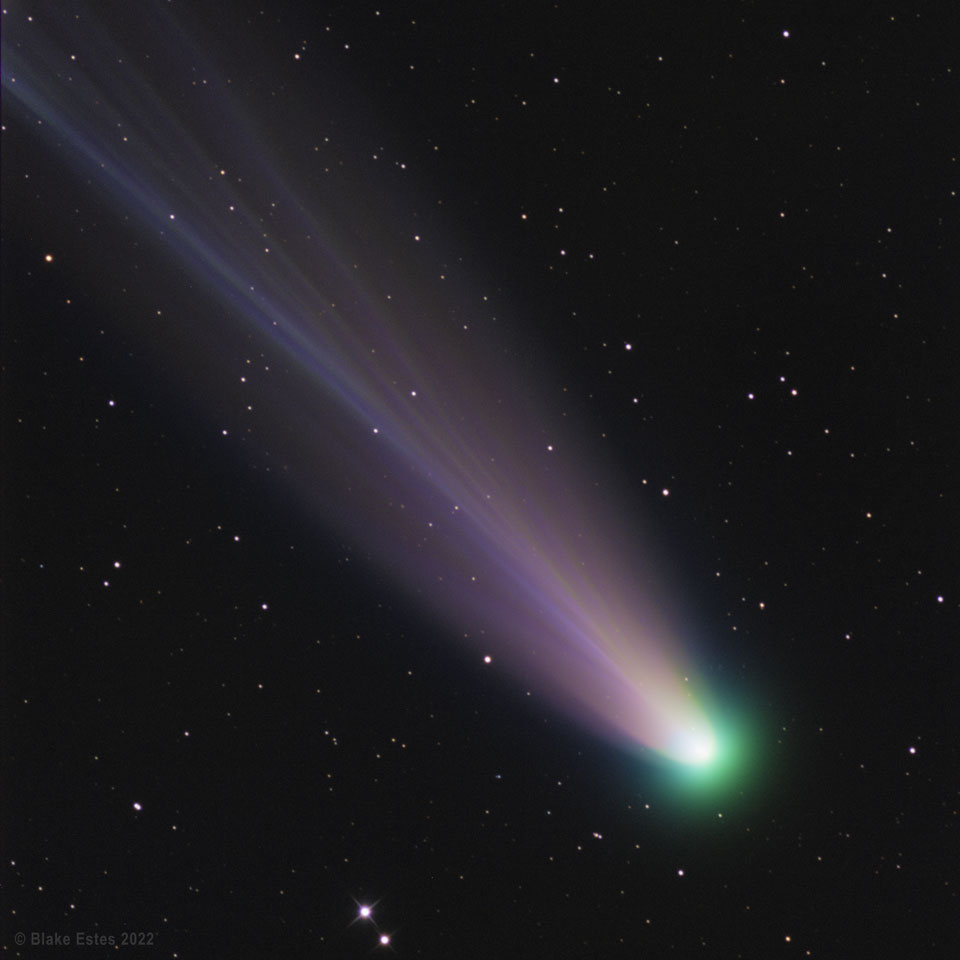2022年1月12日
Comet Leonard Closeup from Australia
Image Credit & Copyright: Blake Estes (itelescope.net)
Explanation: What does Comet Leonard look like up close? Although we can’t go there, imaging the comet’s coma and inner tails through a small telescope gives us a good idea. As the name implies, the ion tail is made of ionized gas — gas energized by ultraviolet light from the Sun and pushed outward by the solar wind. The solar wind is quite structured and sculpted by the Sun’s complex and ever changing magnetic field. The effect of the variable solar wind combined with different gas jets venting from the comet’s nucleus accounts for the tail’s complex structure. Following the wind, structure in Comet Leonard’s tail can be seen to move outward from the Sun even alter its wavy appearance over time. The blue color of the ion tail is dominated by recombining carbon monoxide molecules, while the green color of the coma surrounding the head of the comet is created mostly by a slight amount of recombining diatomic carbon molecules. Diatomic carbon is destroyed by sunlight in about 50 hours — which is why its green glow does not make it far into the ion tail. The featured imagae was taken on January 2 from Siding Spring Observatory in Australia. Comet Leonard, presently best viewed from Earth’s Southern Hemisphere, has rounded the Sun and is now headed out of the Solar System.
Tomorrow’s picture: open space
摄于澳洲的李奥纳德彗星特写
影像提供与版权: Blake Estes (itelescope.net)
说明: 近距离看李奥纳德彗星会见到什么?虽然我们不能飞到它的旁边,但用小望远镜拍摄这颗彗星的彗发和紧邻彗核的彗尾,应能给我们相近的感受。顾名思义,彗星的离子尾是由电离气体所构成,而这些气体则是受太阳紫外光的电离并受到太阳风的推送。太阳风具有高度的结构性,而且会受到太阳复杂多变的磁场之雕塑。变幻不定的太阳风作用在彗核释出的各种气体之后,就造就了彗尾的复杂结构。此外,在太阳风的宰制下,李奥纳德彗星的彗尾除了指离太阳也摇摆不定。其离子尾的泛蓝色泽,主要来自与电子复合的一氧化碳分子,而环拱彗核的彗发之泛绿色泽,则来自和电子复合的微量双碳分子。暴露在阳光中的双碳分子,大约50小时就会分解,因此离子尾只有靠近彗核这端才有绿晕。这幅主题影像是在1月2日摄于澳洲的塞汀泉天文台。目前要观测李奥纳德彗星的最佳地点在南半球,而它在旋绕过太阳之后,正踏上离开太阳系的旅程。
明日的图片: open space



